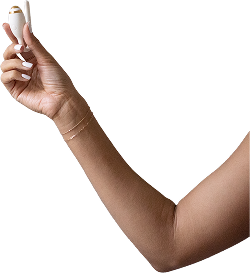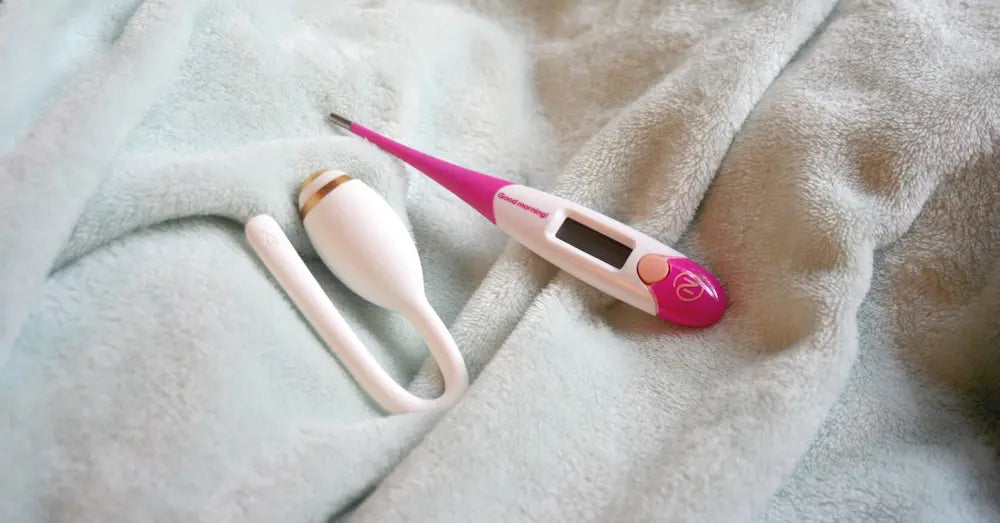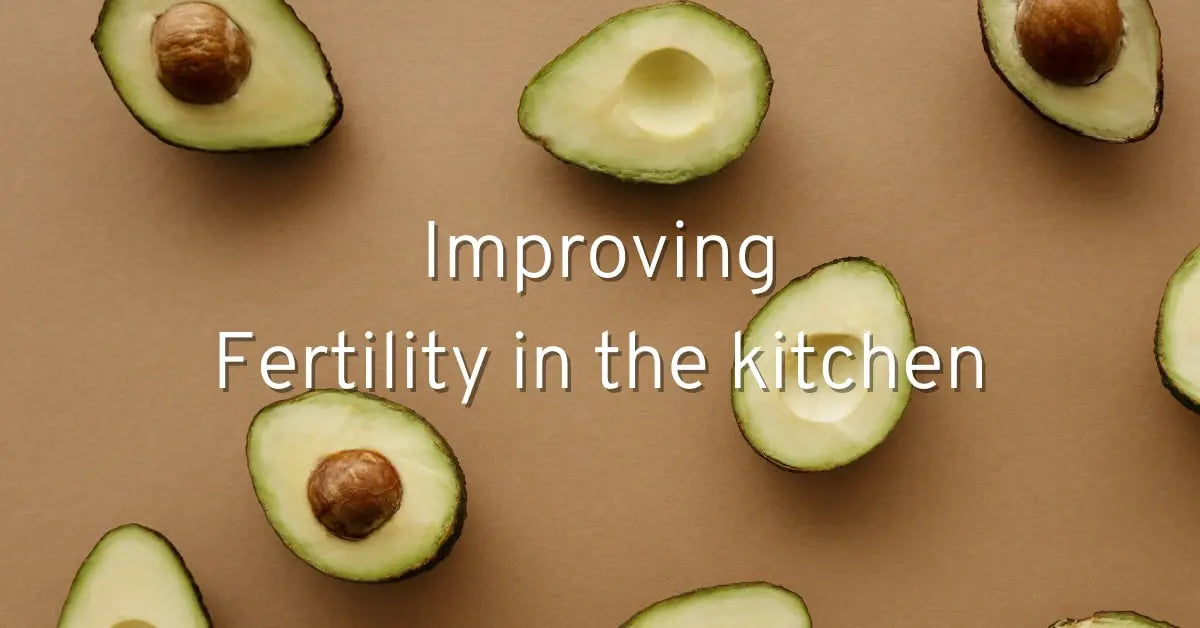At a Glance:
- Natural Cycles is a basal body temperature tracking app-based algorithm that predicts your fertility status
- Natural Cycles has 3 tracking modes, for use in pregnancy, when trying to conceive, and when trying to avoid
- The app can include LH test results in its algorithm
- The Natural Cycles device and app require multiple months of use to refine the prediction; there are many “red days” (potentially fertile days) initially and for users with irregular cycles or PCOS.
- It is hard to pinpoint the most fertile days with Natural Cycles, even after entering your tempshift
- There is a subscription fee that can be purchased monthly or annually
- kegg is a fertility tracker that detects the changes in the cervical fluid and displays the results in the free kegg app
- kegg’s intelligent algorithm predicts the fertile window in advance while the user can also see the real-time changes in their fertility
- kegg is intended for those trying to conceive and those who wish to track their cycles. kegg is not recommended as a standalone contraceptive tool, although you can use kegg to complement your own tracking.
- Users with irregular cycles and PCOS are able to spot their “fertile valley(s)” to optimally time their trying to conceive efforts, even without a fertile window prediction
- Kegg is a one time purchase that is used at a time of day that is convenient for the user for only 2 minutes a day.
- kegg helps users confidently time their trying to conceive efforts
Natural Cycles: What’s it all about?
The “Cycler”, or a Natural Cycle’s user, records her basal body temperature, or the body’s lowest resting temperature, upon waking each morning and inputs the recording into the app. The included thermometer is accurate to two decimal points. The Natural Cycles’ algorithm uses temperature, period, and cycle data to determine if a given day is green (not fertile) or red (potentially fertile) for the user.
When you start to track your cycle with Natural Cycles, initially you will get more red days, or days that are considered potentially fertile. As it records more cycles and the algorithm gets to know the user better, you will get more ‘green days’, or days which are predicted to be non-fertile.
The Natural Cycles algorithm will include LH in the calculations but this feature is optional. In addition, users will have the possibility to exclude a temperature for illness, poor sleep, or a hangover (yep!).

Natural Cycles works for irregular cycles, but users may get more red days if the algorithm can’t Identify the estimated ovulation day and if you suffer from PCOS or a thyroid condition, you will likely get more ‘red days.’ Despite this, it will still provide predictions.
Women who have been diagnosed with PCOS often suffer from cycle irregularity or absent periods due to anovulation. For this reason, it might be difficult to not only predict ovulation but also confirm it with Natural Cycles for women with PCOS.
My Experience
I have been using Natural Cycles for 9 months. To me, the app feels a bit ‘clunky’ and slow. I also find it a bit tedious to add my temp with their style of number pad, which if it is something you are doing daily upon first waking, I feel like it needs to be more user friendly!
I found it very interesting and somewhat confusing that regardless of whether you are TTA or TTC, the color coding of the fertile days (red) and non fertile days (green) remains the same. When TTC, seeing red on my fertile days feels like a stop sign. When I shifted from TTA to TTC, I had to remind myself daily red means these are my days for timing intimacy.
For the first cycle with Natural Cycles, the app places a fertile window prediction based on a typical cycle length. Since my cycle is usually 27 days, I happened to fall well within the “typical” cycle length, but I know this would not be the case for many! Since you get mainly red days initially, it’s just a waiting game watching temps until a shift occurs. They encourage LH testing to help pinpoint ovulation which I thought was interesting since BBT and LH testing often miss the most fertile days leading up to ovulation. When TTA I wondered how accurate it could be catching the very early fertile days. I realized quickly it errs on the side of caution with an abundance of red days, which although may be safer, is limiting for couples and seems more like a guess than an objective measurement. On the flip side I had some cycles that said I was no longer fertile when I definitely still was.
I had trust issues:
I don’t quite understand the Natural Cycles’ method. In most cycles my red fertile window ends 2 days after the “ovulation” icon. But I have one completed cycle with the ovulation icon AFTER the end of the fertile window which does not seem logical to me.


Cost
- Natural Cycles is a subscription based service.
- You can opt to pay $6.99 monthly without the thermometer or sign up for a full year for $89.99, which includes the thermometer.
- At first, I thought this seemed inexpensive but when I considered that I was paying that much for an app and I considered my remaining years of fertility, I was baffled by the hefty investment in just the cost of the subscription service!
What about kegg?
With kegg, there are two fertility goals you can select from: TTC or Cycle Tracking. They state it is not recommended to be used when TTA on its own. Before TTC, I used kegg to track my cycles, but also used the Sympto-Thermal Method. *kegg is not recommended to be used as a standalone contraceptive tool. Many women complement their own tracking with kegg.
kegg predicts the fertile window in green days. Unlike Natural Cycles, the fertile window is always predicted to be 5 days in length, which is intentional, as kegg is intended to show you your most fertile days. Since sperm can typically live for a maximum of 5 days, this is logical.. For the first cycle, kegg places the fertile window prediction based on the cycle length you tell it when you set up your account. After the first cycle, the algorithm kicks in and uses your trends it learned in the first cycle and every cycle moving forward to predict your fertile window. It becomes more and more personalized with each cycle of kegg data.
I learned quickly that the fertile window looks like a dip in my kegg readings. This is called the “fertile valley”. When I would start to see my readings going down, it clued me in that I was entering my fertile window, even during my first cycle. I liked this, since I didn’t have to rely on kegg’s predicted fertile window only. I enjoy “seeing” my fertility data and after I take each reading, I look to see where my value is plotted for the day. I also like that I don’t need to use kegg upon waking. I use kegg in the evening and appreciate the flexibility in selecting the time I use kegg.

Data will appear in the kegg app in a trend form. While each reading appears exactly as it was recorded, the app provides a trendline (dark green) that helps smooth the data to better see the overall trend. I find this to be really helpful, particularly when looking for my dropping values that indicate I am likely fertile. When I see my readings go up again, I know I have likely ovulated and my fertile window is ending. While I still get little drops and rises throughout the remainder of my cycle, I know that if my dip falls during (or close to) the prediction, these other bumps are natural hormonal fluctuations of the cycle.
You might have heard: kegg is not clinically tested in women with PCOS but many women with PCOS who ovulate and have periods have been able to identify their fertile window thanks to kegg and successfully conceive.
I heard in the Facebook Community about another user with irregular cycles who was able to look at her trend line data to discern when she entered their fertile window. Since the electrolytes in the cervical fluid fluctuate according to the hormonal changes of the cycle, the kegg user can look for descending values on their kegg readings to predict when they are entering their fertile window. While kegg does not detect ovulation, the rise that occurs at the end of the fertile window may indicate ovulation has occurred as the rise in progesterone results in a change in the electrolytes of the cervical fluid.

The Investment
- kegg costs $259 and the kegg app is free-there are no subscription fees.
- The device itself feels durable and well-constructed, and I feel it will last me for years to come.
- While it was an investment upfront, I like that I do not have any recurring costs moving forward
Similarities
Both Natural Cycles and kegg use predictive algorithms. These algorithms need to learn about the user’s trends and both get more accurate with each cycle. It is important to be consistent using both Natural Cycles and kegg for the greatest accuracy but if you miss an occasional day with either app, it is okay.
While kegg has a consistent set of 5 fertile days in its prediction, Natural Cycles has varying amounts of Red and Green days which fluctuate over time. While both can be used to track irregular cycles, there may be more Red days with Natural Cycles due to the difficulty predicting. Comparatively, kegg will not provide a prediction for cycles outside of the 21-40 day range, however, users can watch their trends to look for descending values which would suggest they’re entering the fertile window.
So, how do I rank these two tracking methods?
The greatest feature of kegg is being able to watch your own trendline and understand the data about your body as it is unfolding.
While the fertile window prediction is helpful, I find myself caring more about my readings and more confident when to time intercourse now that I am trying to conceive.
While it does not have a TTA mode, I appreciate that kegg compliments my own tracking using the Sympto-Thermal Method and gives me added confidence.
Since the window for possible conception is limited to about 5-6 days, being able to see exactly when this was happening with kegg is really powerful for me. While both devices have numerous benefits, I feel the benefit of seeing your fertile window unfold with kegg outweighs any of the benefits Natural Cycles offers.




